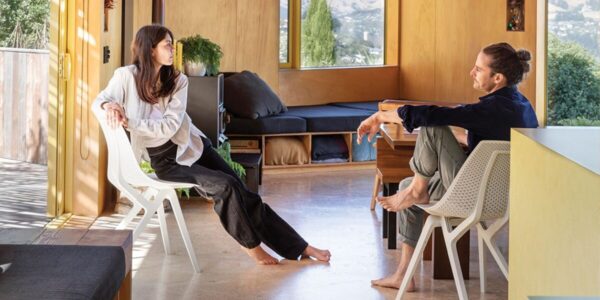
Creative family cabin
A mountain getaway conjures up images of a place to relax and unwind, full of long, slow days spent doing a lot of nothing. But near Yosemite National Park, the 35-year-old vacation compound built by the Pfeiffers ― a close-knit family of artists and craftspeople ― is a different kind of retreat. It’s more like a creative workshop that feeds the imaginative spirit of three talented generations of occupants.
Eric Pfeiffer, an Oakland-based product designer (read the March 2005 profile “New Wave Designer”) and owner of 10 Grain design studio, was 2 years old when his father and maternal grandfather built the cabin in 1971. He and his sisters ― Lisa, a painter, and Jenny, a photographer ― spent their summers here exploring and developing their creative chops. “My grandfather had a big influence on us,” Eric says. “He taught us just to make something out of what we have.”
Evidence of that is everywhere in the cabin: beautifully crafted doors, rough-hewn log benches around the firepit, a handmade quilt on every bed. Each project comes with a story and vivid memories of its creation. “When I look back at my youth, the best times I had were here, making things with my father and grandfather,” Eric says.
Time spent at the cabin helped Eric form the basis for much of his professional design. “The direct relationship of form and function has definitely influenced my thinking ― have an idea, see the potential in the raw material, then make it in the simplest way,” he says. In the kitchen, three rows of hand-carved wooden pegs hold a giant collection of coffee mugs; in the hallway and stairwell, family photos are clustered in whittled twig frames. Outside, a winding pathway of planks forms the route to each of three tent cabins (built by Eric and his wife, Melissa, over the course of one summer) and the shared outdoor bathhouse (built by Eric’s father). It’s all like useful sculpture: rational, straightforward, and beautiful. As Eric puts it, “The way things get made here ― messy, dirty, and unfinished ― is the purest design process of all.”
Resourceful beginnings
Eric’s father, Gene, owner of an electrical contracting business (and now an avid paraglider), has been vacationing in this part of the California Sierra since he was 6 weeks old. He purchased this land from his own father in 1966, then collaborated with his father-in-law, George Bianchi, a bridge builder, to design the cabin.
The two men had the external structure built in 1971, then did all the interior finish work themselves, including laying floors, putting up walls, and building the stairs to the sleeping loft. Gene says they “sort of camped in the house that whole winter, with tin-can lids covering knotholes in the floor,” making do with a temporary kitchen and an outhouse. After learning “water witching” from an uncle, Gene and his brother drilled a well that produces enough water to serve their cabin and two others nearby. In the spring of 1972, they put in the permanent kitchen and bathroom, and the cabin was officially open for use.
George made the kitchen cabinets from wood scraps left over from the construction of the frame. Gene built a lot of the furniture, including most beds, the dining room table, and a cupboard that now houses a treasure trove of quilting remnants. Exposed steel bracing for the cabin frame was hand-cut from the discarded floors of the San Jose Mercury News printing presses. “My dad builds stuff as we need it, and it all lasts for decades,” Eric explains. “Then when something breaks or wears out, we just make another one.”
Five years ago, the family decided some updates were in order, since the brood was continuing to grow in number, and some of the cabin’s original elements were showing their age. Linoleum flooring throughout the structure was replaced with pine everywhere except in the most heavily trafficked and water-prone areas ― the kitchen, the front and side entryways, and both bathrooms, where they laid slate instead. The shower in the full bathroom was expanded, and a powder room was created in place of a closet.
Collaborative cooking had become a big part of life at the cabin, so the kitchen was refreshed. New appliances were added to handle larger meals (and more cleanup), and a bigger island was built, with cabinets underneath to match George’s originals. Now, when the kids are drawing on the chalkboard-covered refrigerator, two people are preparing lunch, and someone else is still working on breakfast, there’s enough room for everyone.
Artistic heritage
On a recent weekend visit, Eric’s mother, Joann ― who conducts a weeklong art camp at the cabin each summer for a group of Oakland public-school kids ― was up early making her famous cinnamon rolls and showing Eric’s 8-year-old daughter, Keegan, how to cut them to the perfect size. “Coming to the cabin has been our one constant over the years,” she says. “It gives us time for creativity ― something that’s often hard to come by in our day-to-day lives.”
After breakfast, Joann leads various family members in making homemade tortellini while others migrate toward their own creative pursuits. Lisa makes mixed-media collages with fabric scraps and paint; Jenny photographs the happenings indoors and out; Eric and Melissa (a graphic designer and owner of the Oakland-based design store Modernseed) help Keegan and her 5-year-old brother, Luke, form tiny clay sculptures at the dining table. The family legacy, it seems, is alive and well.
Elements of a great family cabin
The Pfeiffers’ Sierra retreat is full of simple ideas that create a casual, comfortable environment.
Dining alfresco Cooking and eating outdoors, with informal seating and room for kids to roam, make meals for large groups easier and more relaxed.
Hardworking kitchen Numerous work surfaces, including sideboards and a table that can be annexed during meal prep, invite multiple cooks to participate in a fun family activity.Improvised sets Hosting a crowd calls for a lot of dishes. A mismatched stock of plates, flatware, and coffee cups allows for the easy addition of new pieces.
Room to rest A house doesn’t need to be huge to sleep a lot of people. Kids love piling together in a sleeping loft. In the Pfeiffers’ case, the addition of tent cabins provides privacy for adults.
Nostalgic displays Family memorabilia not only adds a personal touch, but also brings back fond memories of previous escapades. The Pfeiffer cabin walls are covered with old skis (some of them broken), photos from past years’ events, kids’ artwork, and visitors’ contributions.
Tranquil touches Invoking serenity indoors and out helps guests transition to a getaway state of mind. Peace-inducing ideas include cozy hearthside curl-up spaces and pathways that meander into the natural surroundings.
Resources: Bedroom Pioneer 12- by 14-foot tent cabin ($3,800) from Sweetwater Bungalows (800/587-5054). PS cabinet in red ($100) from Ikea (800/434-4532). Bent Ply by Eric Pfeiffer and Dung Ngo (Princeton Architectural Press, 2003; $45) from Modernseed (866/301-9635). Kitchen Foto pendant lamp in aluminum ($8.99) from Ikea (800/434-4532).
